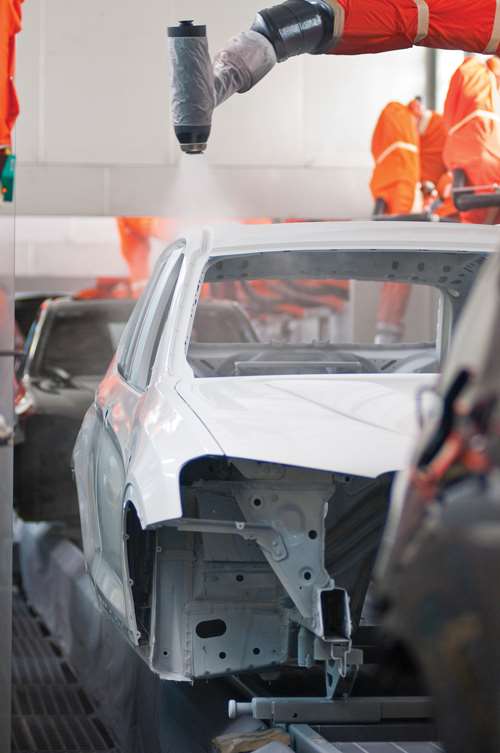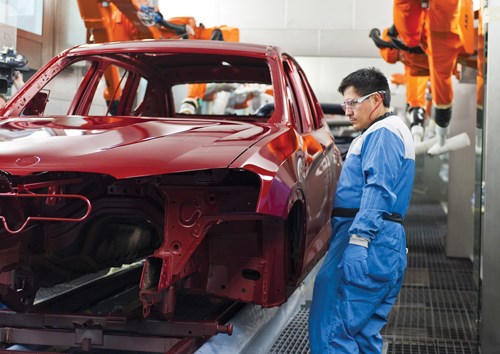Two years ago,
PPG launched the first use of waterborne compact paint technology in a U.S. automotive manufacturing plant at the BMW assembly plant in Spartanburg, S.C. This painting process has turned out to be a 2012 award winner and has opened up a new way for auto manufacturers to go leaner and become more efficient in their operations.
The B1:B2 process—which stands for basecoat one, basecoat two, applied wet-on-wet— saves time, cost and emissions because it enables automakers to eliminate a step in the coating process, and makes separate paint booths and oven dryers unnecessary.
Savings on Capital, Operating Costs
According to PPG, the process saves on capital and operating costs by reducing the manufacturing footprint of a paint shop, reducing energy consumption and increasing overall process efficiency.
“Our waterborne B1:B2 technology highlights our dedication to helping our customers reduce the overall paint shop footprint and environmental impact, while achieving superior appearance and maintaining color flexibility,” says Bob White, PPG’s director of global accounts for BMW.
In the traditional automotive paint process, the application of pretreatment and electrocoat is followed by a primer layer. After the primer layer is cured, a topcoat layer of basecoat and clearcoat is applied and cured. Because this process is both costly and time-consuming, it has become a focus for streamlining.
White says the next-generation B1:B2 technology works within BMW’s integrated paint process and enables the car manufacturer to reduce the number of steps necessary to paint a vehicle by moving the traditional primer application into the topcoat booth.
“This movement eliminates the dedicated primer booth and all related processing,” he says.
The B1 layer provides primer, filling, chip and durability benefits, while the B2 layer provides color and additional durability. Both layers are applied wet-on-wet and do not require baking or a heated dehydration process in between.
Faster Painting Process
Since implementing the coating process, BMW has reported energy savings of as much as 30 percent, a 43-percent drop in carbon-dioxide emissions, and a 7-percent decline in volatile organic compounds. The company also says the new process reduces the time it takes to paint a single car by about 15 minutes, which is substantial since the Spartanburg plant builds close to 1,000 cars a day. The plant, which opened in 1994 and employs more than 7,000 people, produces the X3, X5 and X6 sports activity vehicles.
According to Josef Kerscher, president of BMW Manufacturing in Spartanburg, the U.S. is the BMW Group’s largest market, where it sells more vehicles than in its home country of Germany. Improving and speeding up the paint process was needed to meet a growing demand for BMW vehicles.
“With our flexible production processes and flexible supply chain, we were able to increase the daily production volume by more than 30 percent to meet demand,” Kerscher says.
He led BMW through a $750 million expansion in 2008 in which the paint shop upgraded to the new B1:B2 system. The plant currently is undergoing an additional $1 billion expansion that will increase production and add about 1,400 more jobs to the facility.
The BMW paint shop covers about 700,000 sq ft, and every vehicle receives two protective corrosion coats, sealant, primer, basecoat and clear coat. In all, there are more than a dozen stages in painting a BMW, and a computerized tracking system monitors every car through each stage over the six miles of conveyors in the paint shop.
It takes about 12 hours to complete the painting process on a vehicle, during which time the vehicle travels about four miles. The paint shop produces a finished vehicle every 78 sec, or 46 units each hr. More than 4,000 gal of paint travel through about 13 miles of stainless steel pipe.
The company says it is the first “green” paint shop in the world, using methane gas from a nearby landfill to power its ovens and most of the equipment used in the coating area. About 3/4 gal of paint is used for the base coat of a vehicle, excluding clear coat. After all coats are applied, the total paint thickness is 120 microns.
BMW calls the paint system its new “integrated paint process” (IPP) but it was already being used in the Oxford, England, plant where the company builds the Mini Cooper.
“Using IPP, we were able to do away with one complete step in comparison to the old paint process,” Kerscher says. “Adopting IPP reduced our capital investment and will mean considerable savings in running costs while increasing our energy efficiency, too.”
Award Winner
PPG was named a 2012 Automotive News PACE Award winner for the B1:B2 compact paint system, marking the eighth time the company has received the award that honors automotive suppliers’ innovations in products, manufacturing processes and information technology. PPG won in the manufacturing process category, which recognizes innovations that have significant market impact and act as “game changers” in the automotive industry.
“We were honored to receive the PACE Award once again, as it highlights the innovative spirit of our company,” says Cynthia Niekamp, PPG senior vice president for automotive OEM coatings.
For information on PPG, please visit ppg.com/coatings/industrial/Pages/default.aspx.
RELATED CONTENT
-
Fostering Sustainable business and People success through new ways of thinking
-
The Dürr Group and Osaka-based firm Techno Smart have partnered to increase EV battery production efficiency. The Dürr Group is also expanding its small-factor battery production tech business and contributing to EV production across multiple departments.
-
How one company is prospering by providing flexible e-coat capability to Nissan and other customers.

















